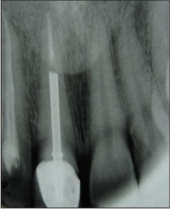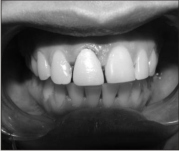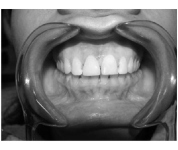INTRODUCTION
All ceramic crowns were used to be made up of single layer glass ceramic. Their failure rate was high in
certain cases.1,2 A new system was developed to overcome these failures by utilizing a bilayer design, where an Alumina base core either glass infiltrated ( Inceram, Vivadent)3 or densely sintered (Procera, Novel Biocare) 4,support the veneering porcelain applied over this core for aesthetic purpose. These systems have shown a lower failure rate for single crown.5 Recently, densely sintered Zirconia based cores have been introduced.6,7 These ceramic systems utilize Yttrium-Tetragonal Zirconia polycrystal (Y-TZP or partially stabilized Zirconia) for the fabrication of anterior and posterior crown and fixed partial dentures. “Transformation toughing” where the presence of stabilizing oxide yttrium oxide holds the material in a stable tetragonal state, provides a unique toughing mechanism to enhance the ceramic properties for load-bearing application.8 Y-TZP has flexure strength of 900 to 1200 MPA, which is considerably higher than that reported for densely sintered alumina9 and glass infiltrated alumina / zirconium dioxide material.10 In addition, Y-TZP does not seem to be as sensitive to moisture - induced strength degradation as other ceramics.11 The present case report describes the restoration of an upper right maxillary central incisor
with Zirconia all ceramic Crown (Lava).
CASE REPORT
A 24-year-old girl reported to the Department of Prosthodontics with gray discoloration of gums in relation to upper right front tooth region. The dental history revealed that she got her maxillary right central incisor (11) fractured ten years back which was later root canal treated and a metal-ceramic crown was cemented on the same.
Clinical examination showed the deposition of plaque and mild staining of teeth. The clinical crown of tooth 11 was short as compared to the tooth 21 and there was diastema (Figure 1).
 | Fig 1
 |
An intra oral periapical radiograph of maxillary central incisors revealed post and core in tooth 11 as shown in figure 2,
 | Fig 2
 |
and root canal treatment in tooth 12. There was no periapical radiolucency present in relation to any of the tooth. The treatment Plan included oral prophylaxis, removal of metal-ceramic crown, crown lengthening and fabrication of an all ceramic crown on tooth 11.First, the metal-ceramic crown was removed from tooth 11. The secondary caries present on the labial surface, was excavated and restored with composite. Gingivectomy was done to increase the clinical crown length of 11 (Figure 3).
 | Fig 3
 |
Temporary crown was fabricated with Protem -4 (3M ESPE) and cemented by using non-eugenol temporary cement (GC).Patient was recalled after 2 weeks and it was observed that gingiva in relation to tooth 11 was healed properly. The preparation was modified for all ceramic crown, deep chamfer margin was given and gingival
retraction was done before taking the final impression. Final impression was made by using Polyether elastomeric
impression material (3M ESPE). Temporary crown was relined with Protem -4 (3M ESPE) and recemented using
non-eugenol temporary cement (Figure 4).
 | Fig 4
 |
Impression was sent to the laboratory for the fabrication of all ceramic
crown (Lava). The shade of the tooth was determined with a Vitapan Classic shade guide. After a week, temporary crown was removed and all ceramic crown was cemented with self etch Unicem
luting cement (3M ESPE) after doing minor intraoral adjustments. The crown length of tooth 11 was improved
and was in an alignment with tooth 21. Final results were satisfactory in relation to esthetics and function and
patient was quite satisfied with the appearance (Figure 5).
 | Fig 5
 |
DISCUSSION
Although porcelain-fused-to-metal (PFM) restorations are the most widely used full-coverage crown restoration systems, their inherent properties make the achievement of natural aesthetic restorations an elusive task. In contrast, the all-ceramic systems offer excellent translucency and vitality, without the opacity associated with PFM restorations. Its vitality is further enhanced by an adhesive resin cementation method that conducts the color of the underlying tooth structure. Among various all ceramic systems, Zirconia was selected for the fabrication of all ceramic crown in the present case. As an opaquer, it has got better properties to mask the discolored tooth. Hefferman et al suggested that zirconia restoration would be better suited to match opaque, high value teeth.12 The new generation adhesive agents combined with highly filled resin luting cements allow to create an integral unit between the restoration and the natural tooth.13 This bond provides high compressive strength and low microleakage. The present case report demonstrated the preparation procedure, the importance of well-integrated provisional restorations, and the accuracy in transferring provisional information onto the final
jacket crown. It can be concluded that due to their natural appearance, the all-ceramic materials, especially the glass ceramics, blend harmoniously with the oral environment and are particularly appreciated where aesthetics is a priority, especially in the maxillary anterior region.
REFERENCES:
1. Lawn BR et al. Materials design in the performance of all ceramic crowns. Biomaterials 2004; 25:2885-92.
2. Malament KA, Socransky SS. Survival of Dicor glass ceramic dental restoration over 14 years: Part1.Survival of Dicor complete coverage restoration and effect of internal surface acid etching, tooth position, gender and age J Prosthet Dent. 1999; 81:23-32.
3. Probstrowner L, Diehl J. Slip-casting alumina ceramic for crown and bridge restoration. Quintessence Int 1992;23:25-31.
4. Russel MM,et al. A new computer assisted method for fabrication of crown and fixed partial denture.Quintessence Int 1995;26 :757-763.
5. McLaren EA,White SN. Survival of In-ceram crowns in a private practice: A Prospective clinical trial. J Prosthet Dent 2000;83:216-222.
6.Filser F,et al. Reliability and strength of all ceramic dental fabricated by direct ceramic machining (DCM). Int J Coumpt Dent 2001;4:89-106.
7.Besimo CE,et al. Computer assisted generation of all ceramic crown and fixed partial dentures. Int J Coumpt Dent 2001;4:243-262.
8. Lwan BR. Fracture of brittle solids, ed2. Cambridge: Cambridge University Press,1993.
9. Wagner WC,et al. Biaxial flexure strength& indentation fracture toughness of three new dental core ceramics J Prosthet Dent 1996;76:140-144.
10McLaren EA. White SN. Glass-infiltrated zirconia/alumina based ceramic for crown and fixed partial dentures: Clinical and laboratory guidelines. Quintessence Dental Technol 2000;23:63-76.
11 Sorensen JA. The Lava system for CAD/CAM production of high strength precision fixed prosthodontic.Quintessence Dental Technol 2003;26:56-67.
12Hefferman MJ, et al . Relative translucency of six all-ceramic systems part II: Core and veneer materials. J Prosthet dent 2002;88:10-15.
13 McLaren EA, et al. Zarconia based ceramic: Material properties, aesthetics and layering techniques of a new veneering porcelain, VM9. Quintessence dent Quintessence Tecnol 2005;28:99-111. |